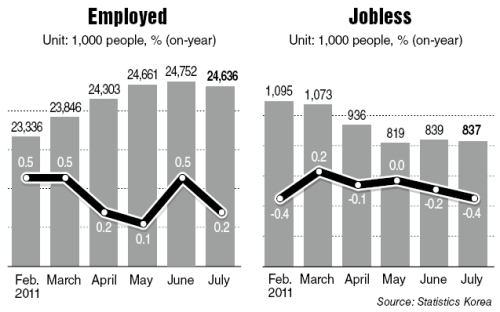
South Korea’s money supply grew at the slowest pace in more than seven years in June as liquidity offered by the government decreased despite brisk bank lending, the central bank said Wednesday.
The country’s M2, a narrow measure of its money supply, reached 1,697.2 trillion won ($1.57 trillion) in June, up 3 percent from a year earlier, according to the Bank of Korea.
The June reading eased from a 3.7 percent on-year expansion tallied in May and marked the slowest growth since a 2.7 percent gain in March 2004.
The M2 covers currency in circulation and all types of deposits with a maturity of less than two years at lenders and non-banking financial institutions, excluding those at insurers and brokerage houses.
“Although bank lending remained firm in June, liquidity supplied by the government declined as the smaller amount of maturing treasury holdings led the government to tap its deposit less,” said Kim Byoung-soo, an economist at the BOK.
The on-year growth in the M2 has been slowing since July of last year when the money supply expanded 9.3 percent from the previous year, as banks have been wary of extending loans despite ample liquidity driven by low interest rates.
The BOK said in a separate statement that the country’s M2 is estimated to have grown at the mid-3 percent range in July as liquidity provided by the private sector rose.
The data underpinned market prospects that the BOK is likely to freeze the key rate at 3.25 percent for the second straight month on Thursday due to high external risks.
Meanwhile, liquidity provided by financial institutions grew 4 percent on-year to 2,189.7 trillion won in June, easing from 4.4 percent on-year growth in May. The June growth rate marked the slowest expansion since the BOK began compiling related data in 1986.
The country’s liquidity aggregate, the broadest measure of the money supply, grew 8.1 percent in June, accelerating from 7.7 percent growth the previous month.
The liquidity aggregate covers currency in circulation, all types of deposits at financial institutions, and state and corporate bonds.
(Yonhap News)







![[Graphic News] More Koreans say they plan long-distance trips this year](http://res.heraldm.com/phpwas/restmb_idxmake.php?idx=644&simg=/content/image/2024/04/17/20240417050828_0.gif&u=)
![[KH Explains] Hyundai's full hybrid edge to pay off amid slow transition to pure EVs](http://res.heraldm.com/phpwas/restmb_idxmake.php?idx=644&simg=/content/image/2024/04/18/20240418050645_0.jpg&u=20240419100350)







![[KH Explains] Hyundai's full hybrid edge to pay off amid slow transition to pure EVs](http://res.heraldm.com/phpwas/restmb_idxmake.php?idx=652&simg=/content/image/2024/04/18/20240418050645_0.jpg&u=20240419100350)

![[Today’s K-pop] Illit drops debut single remix](http://res.heraldm.com/phpwas/restmb_idxmake.php?idx=642&simg=/content/image/2024/04/19/20240419050612_0.jpg&u=)